By 1954, Hudson was in severe financial difficulties, and it was only a take-over by Nash-Kelvinator that prevented the company from collapsing completely. The new company became known as American Motors Corporation or AMC, and over the ensuing years, AMC managed to produce a number of truly interesting cars. This particular 1954 Hudson Hornet isn’t just a clean and tidy example, but the current owner is using the vehicle as a daily driver. That suggests that the car is in sound mechanical health, and is ready to be driven and enjoyed when it finds its way to a new home. The next owner of the Hudson will find it located in Warwick, New York, and listed for sale here on eBay. Bidding on the Hornet has reached $15,000, and the reserve has now been met.
Finished in a combination of Palm Beach Green and Coronation Cream, the Hudson is an attractive looking car. The 1954 model year brought a major restyle to the Hornet, a vehicle that was first introduced to the market in 1951. This resulted in a much “squarer” look for a vehicle that had been renowned for its low and swooping lines. The restyled Hudson was not an unattractive vehicle, and it still retained its “step-down” design, giving the Hornet a very low center of gravity when compared to its competition. The panels on this Hudson look to be very straight, with no obvious dings or dents. The paint is in good condition, with the car receiving a restoration in the 1990s. The owner does identify a few minor bubbles in the paint, but it does still hold a nice shine. In a similar vein, the trim, chrome, and glass, all remain in nice order. The Hornet has been fitted with aftermarket wheels, and while these might not be to everyone’s taste, I think that their style suits the vehicle quite nicely.
Apart from its “step-down” design, one of the attributes that defined the 1st Generation Hornet was its engine. Where most of the car’s competitors offered potential buyers a V8 of some description, Hudson fitted the Hornet with a 308ci flathead 6-cylinder engine. The base engine produced 160hp, but this car features the “Twin H-Power” option. This brought dual carburetors to the table and boosted engine power to 170hp. However, it wasn’t brute horsepower that was the engine’s forte, but substantial amounts of torque that made it an attractive proposition. At 278 ft/lbs, that level of torque made the 308 extremely tractable, and when combined with the car’s inherent low center of gravity, it made the Hornet a car that could be hustled along with impressive speed, especially on twisting roads. The engine in this Hornet has been rebuilt, and the owner states that the odometer was reset at that point in time. That means that the rebuilt engine now has just under 15,000 miles on it. It appears that during the rebuild the engine was treated to a set of aftermarket headers. Those should help the engine to breathe better, and it is possible that the 308 is now pumping out a few additional horses. The Hornet also features an automatic transmission, and the car runs and drives nicely enough to justify the owner using it as a daily driver.
The Hornet’s interior is tidy, but it isn’t perfect. The dash looks absolutely beautiful and is the feature that dominates the interior. The covers on the seats show no obvious signs of rips or tears, but the front seat has begun to stretch and is beginning to show its age. The door trims and rear trims are in a similar state, and while it all remains serviceable, I suspect that the more discerning owner might consider a retrim at some point in the future. Having said that, this is not a task that would be considered to be urgent. That means that the next owner could quite conceivable use the Hornet as it currently stands during the upcoming warmer months, and then undertake any interior restoration work during winter.
When Nash-Kelvinator absorbed Hudson to form AMC in 1954, a 2nd Generation Hornet was already developed and ready for production. This was introduced in 1955 as the first new car from AMC, but by 1957, the Hudson Hornet had been consigned to the pages of history. When the original Hornet was introduced in 1951 it showed so much promise, and 43,666 cars rolled off the production line in that first year. By 1954, the company struggled to sell 24,833 cars. However, even that figure looks impressive when compared to the catastrophic sales of the 2nd Generation Hornet. In 3-years of production, sales fell off a cliff, and during those years the entire production total of all 2nd Generation Hornets fell short of the1954 sales figures by more than 2,000 cars. That sealed the fate of the Hornet, but this car represents a chance for someone to own a great car that deserved to be a greater success than it eventually was. I only hope that this car is eventually bought by an enthusiast who will continue to enjoy and appreciate a true American classic.
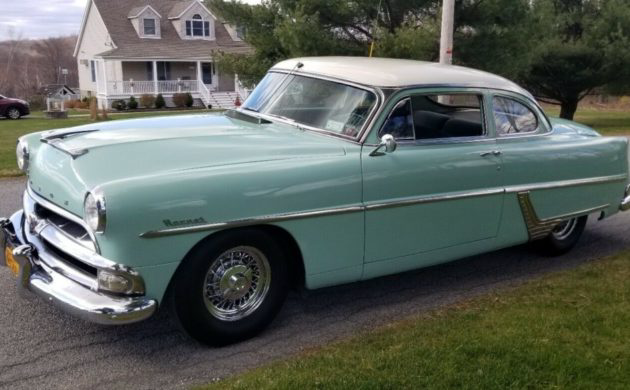

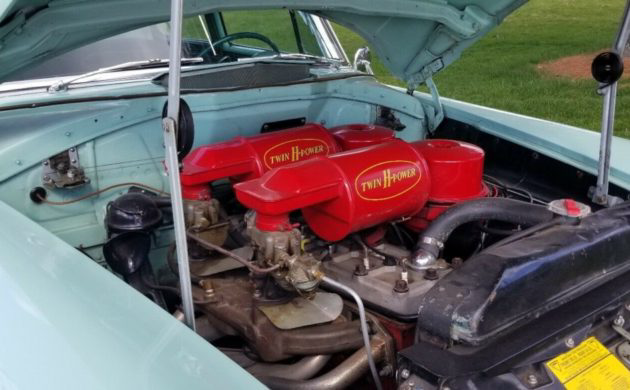


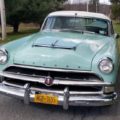
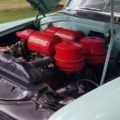
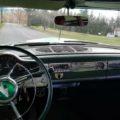




What an absolutely gorgeous car. Glad to see there are still people who love these orphan makes as much as I do. By the time I was born in ‘63, many of the greats were either dead or dying. I never got to live in a world where Packards, Nashes, Studebakers, Hudsons and DeSotos were a common sight on America’s roads. Sometimes I think I was born too late.
I was born in ’57 and they were pretty much off the road by the time I was old enough to notice. However, I did have the privilege of prowling through a junkyard (in the early ’70s) that was populated primarily by those makes, and that’s how I developed an appreciation for them. This car has a reasonable reserve and whoever gets it will be one lucky buyer.
Lovely car. I seem to recall that these Hudsons with the step down frame did very well in early NASCAR racing.
I’ve only read about these, as stated I seem to recall the Hornet doing very well in Stock car racing, question would be was it the car itself or did that flat head six really overwhelm the Oldsmobile and Fords of the day?
This is a good looking solid car, don’t see these at shows hardly at all so that’s a plus.
Multiple carburetion should be taken lightly from back then as they were small anyways, pre-strip dominator days.
https://en.wikipedia.org/wiki/Hudson_Hornet
The only car that looked cool with a factory chop. Hudson is remembered for it’s brief racing history ( Olds kicked their butt,,eventually) but should be remembered for it’s innovations and styling. I’m simply flabbergasted, that a merger between such fantastic cars, only yielded #4 in car makers. That I’ll never figure out.
Howard, you must have posted while I was typing my post below. I whole heartedly agree!
Beautiful old Hornet. These things look like the top was chopped. Had to be the inspiration for chopping a 49 Mercury. What would really look good would be to chop about 2 to 3 inches out of the body. I’ve seen it done to a shoebox Ford and it was quite stunning. A lot of work but if executed properly it would be a sweet custom. Of course I’m not suggesting that this car would be a candidate. It’s much too nice the way it is to start cutting. Someone is going to get a very nice cruiser. I envy the new owner.
Beautiful car , pity about the wheels which are more fitting for a hot rod IMO.
Agreed, Ken. Those wheels….they just don’t look right! The rest of the car is amazing.
I read chrome wire wheels were an option on all ’54 Hudsons.
That may have been, however, I’m sure they weren’t the same as the ones fitted to this car.
You’re correct Ken. The wire wheels on this car are Truspoke wheels for Chrysler products – bolt pattern same as Hudson.
Truspoke: https://www.truespoke.com/?lightbox=dataItem-k7xqd2em9
Barry Taylor’s wiki page shows ’51 convertible w/Hudson wires.
Better looking?
The slightly tatty ’57 2 dr hardtop listed as a low range Super on the Wikipedia page is a Custom.
I was born in 1953 and still remember seeing these cars drive the street in the early 60s. But since there production numbers were nowhere near GM and Ford it was still a somewhat rare site. My Uncle Smitty was a Hudson freak and always had many Hudsons in his collection. It is funny but of all the Hudsons I’ve driven and even owned one. I have never driven an automatic version. I have seen several however. If you watch the old NASCAR races on the beach and dirt. These cars weren’t so much fast as they made up a lot of time in the corners and were able to hold off the competition until the next corner where they would gain a few more car lengths. These cars drive very nice. And have a ride quality all their own. ( Just like a Jaguar has it’s own ride quality.)
I still watch for a deal on a Hudson. Buy they are getting to be out of my “play thing” budget.
Actually, the ’55 Hudson was not a second generation Hornet. When Nash and Hudson merged in ’54, the step down Hudson was dropped–it came out in ’48, and the new Hudson was actually a rebadged Nash which had come out in ’52. The outdated body along with less than attractive styling spelled doom for the big Nashes and Hudsons. Hudson people refer to the 55-57 Hudsons as Hashes.
Had a 51 Pacemaker stick with overdrive. A tough and safe car. It would eat up highways at 80 mph all day and not hard on gas. No mechanical repairs. But paint went south and I repainted it. Great car!